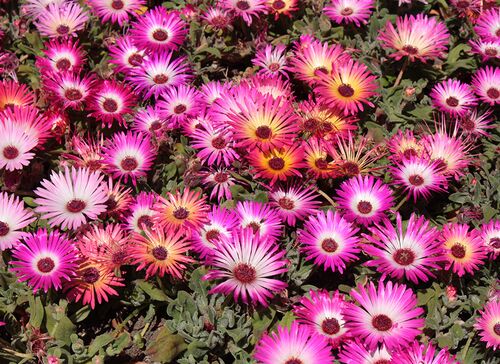Growing and Sowing of Livingstone Daisy

The annual Livingstone Daisy, also known as iceplant, are colourful, low-growing bloomers from the Aizoaceae family (succulent family). Depending on the species, the Latin name is Dorotheanthus or Delosperma. The flowers only open when there is enough sunlight and close when it is cloudy or in the evening. These plants are ideal as ground cover and can withstand drought well. There are also perennial ice flowers.
Sowing and growing Livingstone Daisy
Livingstone Daisy is a low-growing, colourful plant that do not require much care. They are often used in gardens, for example as ground cover, but also do well in window boxes. Note that the flowers only open when there is sufficient sunlight, so the location is very important. The flowers are colourful, resembling daisies, but with a somewhat metallic sheen. The petals often have a shimmering or icy sheen; hence they are called ‘iceplant’.
Sowing Livingstone Daisy
Sow on the surface and press the seeds lightly. Do not cover them with soil, the seeds are light germinators.
Sow indoors or in a greenhouse from mid-March. The plants can be planted out after 5 to 6 weeks, when they have at least two leaves, preferably after ice saints.
From mid-May, after ice saints, Livingstone Daisy can be sown in the open ground. This can be done directly in the right spot or in a seedbed. After about six weeks, when the plants have two leaves, they can be planted out.
When transplanting, maintain a planting distance of 15 cm.
Buy Livingstone Daisy Seeds Online >
Position and soil for livingstone daisy flowers
Sunny positions are very important for these flowering plants. After all, the flowers only open when there is sufficient sunlight. They can be grown in rock gardens or gardens with sandy soil as well as in window boxes, borders and pots. The soil should be airy, poor and well-drained. These plants prefer to stand somewhat drier.
How to care for your Livingstone Daisy plants
Livingstone Daisy needs little care. Give little water, only in prolonged drought. Fertilising is not necessary either, too much fertilising leads to more leaf growth and fewer flowers. Regularly removing spent flowers stimulates flowering. Pruning is not necessary.
Are Livingstone Daisy plants bee and/or butterfly friendly?
This depends on the species, but in general they attract pollinators. The annual varieties are mainly grown for the flowers. These contain less pollen and nectar.
Livingstone Daisy in the vegetable garden
The annual Livingstone Daisy may attract fewer pollinators, but this plant can certainly be useful in a vegetable garden. The plants stay low, grow quickly, and can suppress weeds. In addition, they bring colour and cheerfulness to the vegetable garden.
Is Livingstone Daisy edible and/or medicinal?
Most types of Livingstone Daisy are edible but not medicinal.
Please note, we at Dutch Garden Seeds do not give medical advice. Always ask a professional if and how the plant can be used medicinally.
Livingstone Daisy seeds in our collection
In our range we have Livingstone Daisy seeds from the brand 'Buzzy Seeds'.
Tips for growing livingstone daisy flowers
- Regularly remove faded flowers. This will make the plant bloom for longer.
- Livingstone Daisy are excellent ground cover. This prevents soil erosion and the growth of weeds.
- Give little water and no nutrients, this promotes flowering. Water regularly, especially during dry periods.



